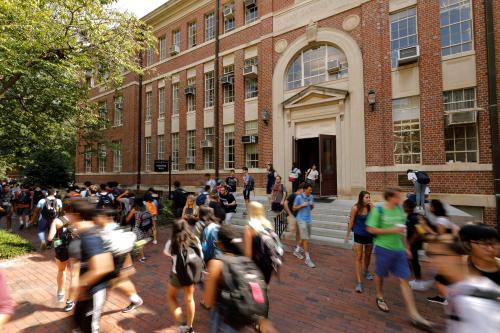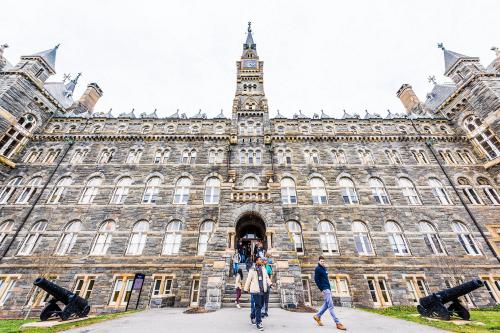This story was produced by The Hechinger Report, a nonprofit, independent news organization focused on inequality and innovation in education.
Building a new school can benefit a community in more ways than one. Sure, there’s the value of a new educational institution where students can take classes and graduate with their diplomas, but why wait years for that spanking new building to pay off?
Schools matter, but so does having a job. There is a high correlation between educational attainment and family income. Families in which parents are part of the workforce are more likely to send their children to college than families in which parents are unemployed. Instead of celebrating construction of a new school only for what it will offer students over the long term, we should also see it as an opportunity for underemployed family members to improve their children’s schooling through the result of their own employment.
Some construction jobs pay above local averages, presenting opportunities to uplift an entire community. For example, in New Orleans, the median hourly wage is $16.36 per hour; some construction jobs pay more than $20 per hour. Instead of waiting for years for a new construction to pay off, it’s time urban planners and education officials focus on investing in the community from the moment the first brick is laid.
New Orleans can be deliberate in providing construction jobs to local residents
Delgado Community College in New Orleans, Louisiana began construction on a new campus in the city’s West Bank community of Federal City in May. The blueprint calls for a 37,000 square-foot facility that will include classrooms, laboratories and faculty offices. Slated to open in two years, the Delgado West Bank Campus Advanced Technology Center will offer two-year and certificate programs in science, technology, engineering and math (STEM) fields. The new facility will enable Delgado to add an additional 2,000 students to the 2,500 it currently enrolls at its existing West Bank campus.
The New Orleans newspaper The Times-Picayune reports the new facility will cost an estimated $9.4 million. State Sen. Troy Carter (D-New Orleans) told the paper that the new campus will anchor other planned developments in Federal City that could result in over $100 million of investments in the area.
Not only should local newspapers and consumer protection groups follow the $9.4 million going toward the construction, they should demand that the New Orleans residents who need jobs and education the most benefit from the 10,000 potential private and government jobs developers and politicians are working to create in Federal City.
Just like any construction project, building a new college campus offers economic and educational opportunities through training and jobs to people without a postsecondary degree—something the black-majority population of New Orleans desperately needs. Discriminatory practices in schools and the job market create disparities in household income and educational attainment between black and white residents. In 2016, black households in the New Orleans metropolitan area earned 54% less than white households, as compared to the national disparity of 39%, according to a report published last year by the think tank the Data Center. The report also found that more than 85% of white people have some college education, compared to only 55% of black women and 42% of black men in the same year.
In 2016, black households in the New Orleans metropolitan area earned 54% less than white households, as compared to the national disparity of 39%.
The authors of the report, Allison Plyer and Lamar Gardere, wrote: “Leaders in all sectors, not just economic development, can examine their own impact on minority communities and consider how they may be contributing to these disparities—thinking ‘outside the box’ about how to turn them around.”
Underserved workers fighting for consideration
When it comes to school construction, communities must be deliberate about incorporating work agreements into the building contracts—something New Orleans struggled with in the aftermath of Hurricane Katrina. Based on federal and state estimates generated at the 10-year anniversary, the federal government spent approximately $120 billion on Katrina-related recovery projects, which is almost three times the state’s annual budget. In 2010, $1.8 billion went toward the rebuilding of New Orleans schools specifically. However, 10 years after the storm, poor black people were as poor as they were before the storm.
By 2013, the white median income had climbed to $60,000, exceeding their earnings in 2000—pre-Katrina—by 40%. Meanwhile, the median black household income was $30,000—$5,000 less than it was at the beginning of the decade. Approximately 33,000 low-income residents did not return. If they had returned, the numbers likely would be worse. According to the Bureau of Labor Statistics, the annual mean income for people working construction jobs in New Orleans-Metairie-Kenner area was $34,460 in 2006. Clearly, the black population could have benefited from some of those construction jobs.
In 2012, the state department of education and New Orleans Public Schools established Disadvantaged Business Enterprises (DBEs) goals, which aimed to steer contracts to underrepresented groups, including black and female contractors. The state reported that $146.2 million in DBE contracts had been awarded as of March 2015. As a former charter school leader in New Orleans who spent a brief time on the facilities master planning commission pulled together by the district, I can say that state and local leaders could have been much more aggressive about creating job opportunities for residents through school construction projects and other developments after Katrina, like including residents in plans for the construction of two new hospitals and in numerous other rebuilding efforts.
The black community was constantly told about the potential opportunities new schools and other refurbished buildings would bring in the future. Construction of the new buildings was deemed a success. However, black contractors have had to fight to gain government construction contracts in a city in which black people are the majority.
Black people can’t afford to be satisfied simply with the prospect of attending new schools—they need to participate in building the schools, too.
“The lighter the skin color, the greater the access to doing the work in the marketplace,” said independent researcher Annette Humm Keen at a 2018 event in New Orleans examining minority-owned businesses in the city. According to Times-Picayune reporting, then-Mayor Mitch Landrieu said the private investments disproportionately go to white-owned businesses. Keen’s research found that while disadvantaged business owners fared well acquiring city government contracts, they underperformed in public contracts overall. “In one key area where the city doesn’t have to award a set amount of contracts to DBEs—goods procurement—minority- and women-owned business participation is at 7%, far below the 21% regional benchmark,” according to the article.
Black people can’t afford to be satisfied simply with the prospect of attending new schools—they need to participate in building the schools, too.
In addition, Delgado officials should demand similar opportunities for their own students. For instance, Clemson University is turning construction sites into classrooms for civil engineering and architecture students. Dedicated to the STEM fields, the new construction gives current and future students real-world opportunities to learn while also earning money.
Yes, one of the major reasons why we go to college is to get a job. But sometimes school and work are the same place. Telling black families they should wait to reap the benefits of a new school misses the point of why we ask them to attend. What people need are opportunities; school construction offers opportunities in the short and long term.







Commentary
How building schools can create good local jobs right now
June 13, 2019